Stewart Island Hunting Getaway

JESSETHEE-BIKEREVOLUTION
JAMESCASSRELS: TRADIEPROFILE
Issue 38 September/October 2023
WORK HARD, PLAY HARD
Rheem offsite is published bi-monthly by NZ Fishing Media Ltd.
177B Marua Road, Ellerslie, Auckland
Editor: Jason Harman
Designer: Dialog Studio
Sales: Josh Williams 021 862 579
sales@nzfishingnews.co.nz
Editorial Enquiries: jason@nzfishingnews.co.nz

Advertising within this publication is subject to NZ Fishing Media Ltd’s standard advertising terms and conditions, a copy of which is available by emailing grant@nzfishingnews.co.nz.
Cover Photo:
Hunting in the Jurrasic-like forest of Stewart Island. Image
Contents
Seven Years and Counting
ColorCote Tradie Profile: Jesse James Cassrels
Frames Gallery
Tradie BBQ: Grilled Jalapeño burgers
Mental Health Chat: Part Two
Coast to Coast: Rutting Chamois
Yamaha E-bike Revolution
Rheem offsite is proudly printed on sustainable PEFC-certified paper.
The reality is we all have to work. Some of us enjoy what we do, while others aren’t so chuffed. Likewise, some are in a position to change their situation, while others are not.
Recently, I’ve been learning about Stoic philosophy (I know… yawn!) and the thing I’ve realised is that those ancient dudes were actually onto something. The core premise of Stoicism is: control what you can and forget about the rest. In other words, focus on what’s within your power to change – your thoughts, emotions, actions – and try to accept what isn’t: other people (especially their opinions and actions), the weather, daily obstacles, etc.
Sick of your job but can’t change it right now? Happy enough at work but feeling like life is stuck on rinse and repeat? This is the point where the decisions we make offsite become really important. Mix it up.
Seek meaning in your spare time. Try something new. Do as the Stoics do and focus on what you can control –your actions – and your thoughts will follow. Find your reason for getting up in the morning, referred to as “Ikigai” in Japanese culture.
Take a flick through this glorious publication and you’ll see practical examples of this philosophy in spades. Inspiring Kiwis, pushing out into the unknown, seeking adventure and novel experiences. Whether it’s in the dense bush of Rakiura, the leg-burning high country of the Southern Alps, or seeping from a smoky backyard BBQ, this issue has all the answers, if you ask the right questions.
– Jason Harman, Editor.
offsite 03
by Bel Jones.
Find your Ikigai 04 12 14 18 20 21 22 28
Reset
Stewart Island

Rheem 04
Using wilderness as a tool to reconnect
STEWART ISLAND RESET
Words and images by Bel Jones @beljones_
Burnout. It’s something that nearly everyone I encounter and manage to have some sort of sub-surface conversation with seems to be battling with. Whether mental, physical, emotional, or a combination of all three, the neverending pressure to succeed in life and give 100% to every single thing is slowly chipping away at us all and, at some point, something’s gotta give. That’s why I went to Stewart Island.
The opportunity to go to Rakiura arose for me earlier this year, and how could I say no? I’m one of those people who will say yes and dive headfirst into something without having any knowledge or experience beforehand, often accompanied by afterthoughts like, what the f**k have I just gotten
myself into…
But nothing’s learned by staying safe and comfortable at home, and the best way to gain experience is to completely submerge yourself into whatever it is you want to learn. This year, for me, that thing has been hunting. The problem was, I had but a handful of hunts under my belt and the thought of being among other experienced hunters in a place I’d never been filled me with a sense of unease that I’d be letting the team down by being the weakest link – imposter syndrome. Fortunately, what I did have behind me was decades of spending time in the bush, exploring the Aussie outback and four-wheel-driving deep in the heart of the Southern Alps. This vast experience allowed me to feel at ease and confident in my ability to manage
myself in the wild; regardless of just how new I was to hunting, I knew had skills that would come in handy in in remote places.
The trip started off with a night at the Invercargill Backpackers, the crew getting well acquainted by sharing an eight-bed dorm and figuring out who did and didn’t snore. The next day the ferry was scheduled to leave around midday, so after a team brekkie and a quick stop at the supo to top-up on essentials (someone had discovered last minute that we only had four rolls of toilet paper for the entire group, for the duration of the trip) we made our way to the dock where everything was loaded from our vehicles and very full trailer. The beauty of being dropped right on the doorstep of the Kaika hut meant that there were
offsite 05
close to no limitations on what we could take along, not to say that you need to bring everything including the kitchen sink, but on any other expedition carried out on foot, or even in a 4x4, you typically have to be far more conscious about space and weight.
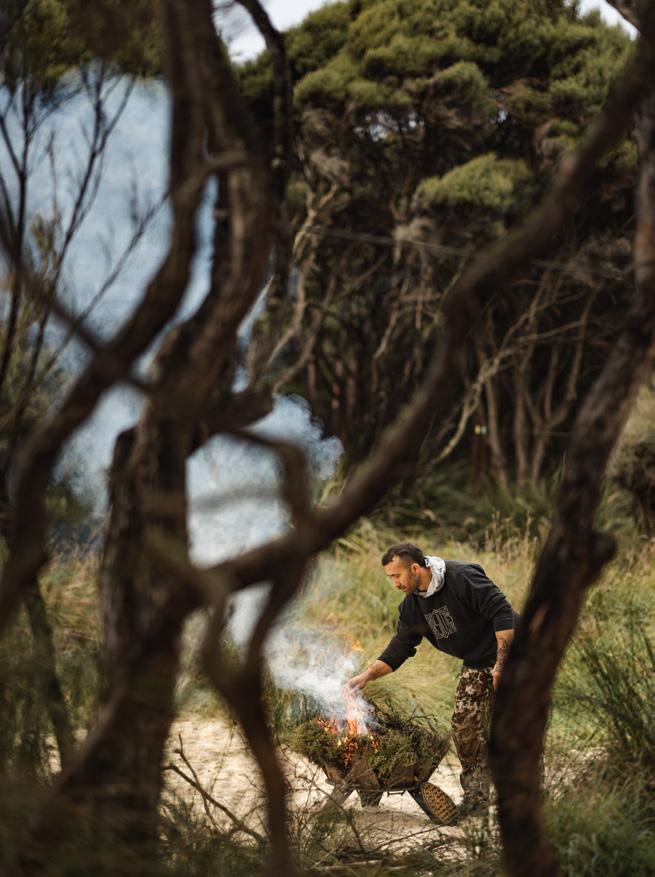
The ferry took about three hours in some choppy water. Thankfully we all got off scot-free, with no one having to hang their head over the edge of the boat. Bumpy ride aside, watching the albatrosses soaring and skimming over the swell was mesmerising, they effortlessly rode the air just centimetres from the surface of the water. Arriving into the bay was like stepping back into prehistoric times, the shore lined with thick, wild forest and the only proof of human existence was a tiny hut – with the bonus of a vibrant rainbow greeting us too. We offloaded all the gear and people from the ferry by shuttling the dinghy to and from the shoreline, loading the little boat up to its absolute limits. However, regardless of the choppy sea, we were
lucky to be completely sheltered in the bay with smooth waters that made getting everything on land easy and straightforward. That afternoon was spent setting up the hut and surrounds for the week ahead, with some of the crew heading out for short walks to check out the flats nearby.
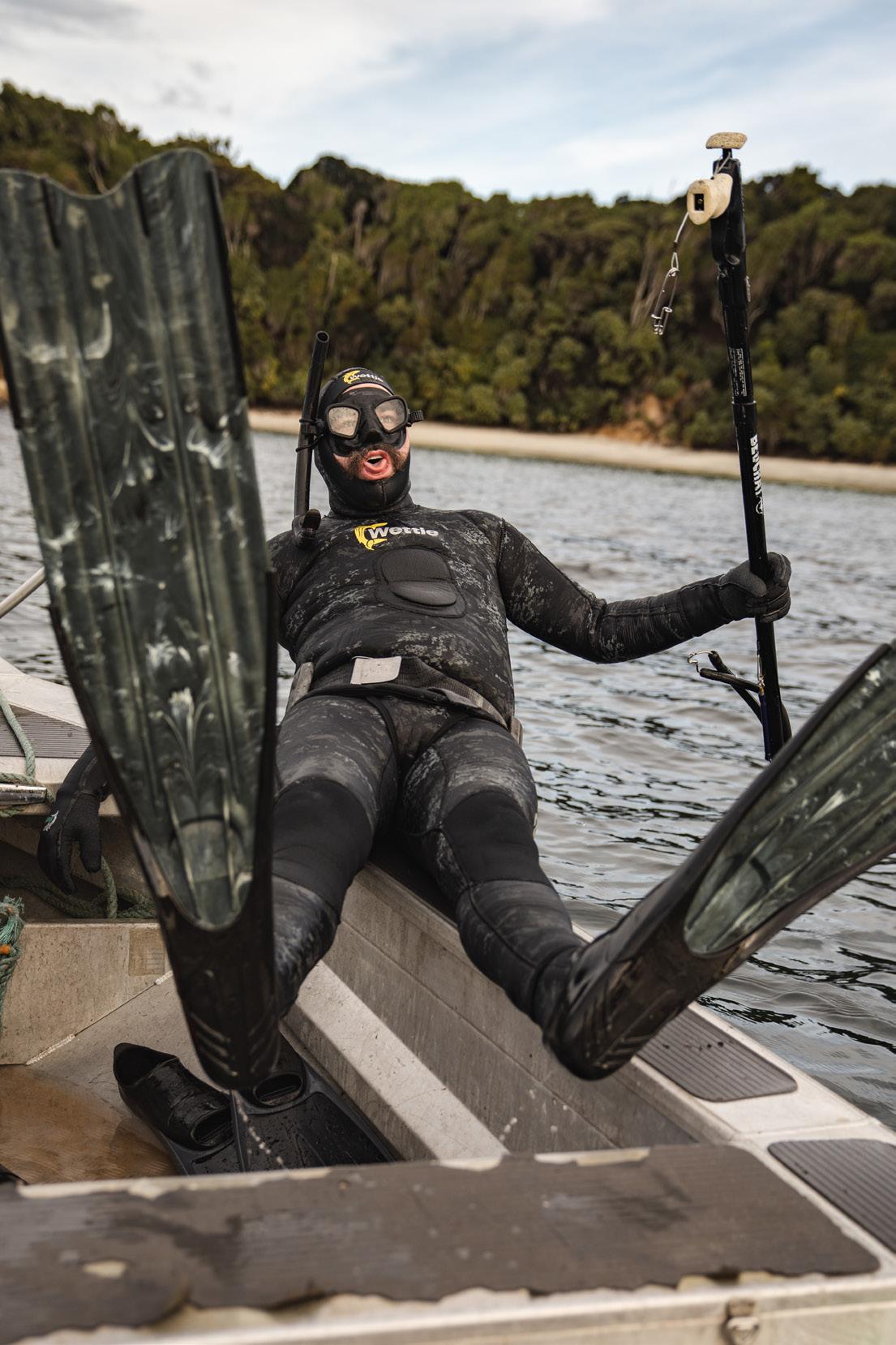
We woke on Sunday morning to the sights and sounds of the ocean lapping at our doorstep and got stuck into planning who was going where in the block so that we were all safely dispersed. The location we chose was a short trip up the coast, so we loaded up the dinghy with our gear and were dropped onto the beach. Immediately we were met with a steep climb up into the forest and had to drop to our hands and knees and clutch at tree roots to get through – half of which were rotten and would come loose from the soil. The top greeted us with terrain completely foreign to me in the sense of hunting. My limited experience had taken me through the wide-open tussock hills of Otago, where you can
see for miles ahead of you, yet here we were faced with only being able to see mere metres ahead. Every step had to be slow and deliberate, trying our best to avoid snapping twigs, swiping ferns and being tangled in the thick vines that trailed from all directions. Completely out of my depth, I followed Kieran’s lead as he is far more experienced than I. He was constantly spotting sign and tracks, the frequency of which naively filled my head with the expectation of surely seeing something in the forest ahead. How wrong I was… The day was filled with slow stalking and a lot of sitting and listening until a thud thud thud came bowling through the ferns. Finally, surely, we’d crossed paths with an elusive whitetail! But as the thudding and clambering came nearer, we realised it was a fat and clumsy Kiwi that stumbled right into us. I’ve lived in New Zealand for 15 years now, but I’ve never seen a Kiwi in the wild before –nor in a zoo, now come to think of it. I was absolutely shocked at how big he was, closely followed by what I can only assume was a smaller female. This was certainly an experience that will stick with me for a long time, completely overshadowing the fact that not a single deer was spotted as the dark crept in and we reached the hut again.
Somewhat disheartened by the perceived ‘failure’ of the day not bringing
Rheem 06
anything back to camp, we quickly learned we weren’t the only ones. A few others from our party had all but spooked one or two of the notorious grey ghosts, instilling a sense of new appreciation and humbleness about just how challenging the hunting was here, and the fact that we were in their territory and under their watch. Fortunately, however, a few of the boys had been out diving and had brought back an abundance of fish and pāua, making up for the rest of us emptyhanded hunters. We spent the night enjoying the big feed of seafood and a couple of drinks around the campfire, along with plenty of laughs and stories told.
Without turning this into a dayby-day rendition of the trip, I’ll skip to the part where we packed up and set off in the dinghy for two nights of camping out at the northern end of the block. We figured that we might be more successful if we were nestled right in their territory, waking up deep in the forest. Another steep climb after stepping out of the dinghy brought us to some of the most open territory we’d been in since landing on the island. We scoped out the best spots for setting up camp and hopefully encountering an animal. The sheer volume of fresh sign was slowly becoming more and more frustrating. We stalked, we were quiet, and we sat for hours upon hours
watching and waiting without a single hint of a deer in our vicinity. The rain rolled in and delivered another layer of challenge, though any slight sound we may have made while moving would have been muffled by the sound of the raindrops, but that also came with the high likelihood of deer bedding down and sheltering from the downpour.
The stillness and silence in that wild and dense forest allowed space for thinking and reflecting a lot on the burnout that I mentioned earlier. How so much time is spent being consumed by fear and worrying about the future, about the unknowns, yet in the middle of that forest the only concerns that needed attention were our most basic

offsite 07
“Arriving into the bay was like stepping back into prehistoric times, the shore lined with thick, wild forest and the only proof of human existence was a tiny hut.”


offsite 09
human needs. Though met with my own unknown of what I was getting myself into when I said yes to going to Stewart Island, the importance was in doing something different and stepping out of my comfort zone – a reminder of the fact that once I was back in ‘civilisation’, no growth ever comes from staying within safe, comfortable havens.

After spending two wet nights in the little hiking tent that my parents had got me for Christmas about eight years ago, we packed up camp as we were being picked up midday to head back to the Kaika hut. A couple of the boys were dropped off where we’d been camped up to see if they could make it further into the northern section of the block, the weather had cleared up and was looking far more promising than what we’d just spent the past few days in.
Back at the hut, we unloaded and got stuck into drying everything off and caught up on what everyone had been getting up to while we had been
out. Again, not much luck except for a handful of sightings, so we got stuck into a few games of Monopoly Deal until we could hear the faint sound of the dinghy returning. One of the boys got up to see if they’d come back with anything while the rest of us stayed in the hut, somewhat expecting the familiar reply of “Nah, nothing today.” However, this time the result was a positive one. The cabin erupted out onto the shore to cheer and congratulate Dan on bringing back a whitetail as he carried it up the beach on his shoulders. It was a magnificent little creature, so much smaller than a red deer yet a decent size for a white tail. Dan filled us in on where and how he’d stalked and shot it, about one kilometre from where we’d camped – confirming just how fresh the sign was that we had encountered in that area.
The deer was skinned and butchered for dinner that evening, taking the back straps to be shared amongst the group in celebration of what turned

out to be the only deer shot on the trip. Hot tip: the best way to cook a pumpkin is by cutting a hole in the top around the stalk, scooping out the seeds, returning the little ‘lid’ and then chucking the whole thing into the fire (or your oven at home). Leave it for what’ll probably feel like too long, then scoop all of the roasted insides out into a tub and mix in butter, garlic, salt, and pepper. This, alongside the seared backsteaks I cooked on the fire, was a big hit with the group and definitely lifted everyone’s spirits after days and days spent in the forest chasing our own tails.
If you’re after an other-worldly experience immersed deep in a Jurassic-like forest, I highly recommend making the trip down to Stewart Island. Whether you’re a hunter or an outdoor enthusiast, the wild and remote terrain will take your brain out of the woes of modern-day life and serve as a powerful reflect-and-reset, regardless of how many animals you do or don’t spot. All expectation was stripped away during the trip and instilled in me a powerful new appreciation for this untouched environment, and the fact that we were deep in the territory of the native fauna and flora. The best memories are made in beautiful, wild places with good attitudes and great company!
Rheem 10
“If you’re after an other-wordly experience immersed deep in a Jurassic-like forest, I highly recommend making the trip down to Stewart Island.”


INDUSTRY LEADING APPAREL AVAILABLE EXCLUSIVELY AT POINTSSOUTH.CO.NZ
Seven Years & Counting
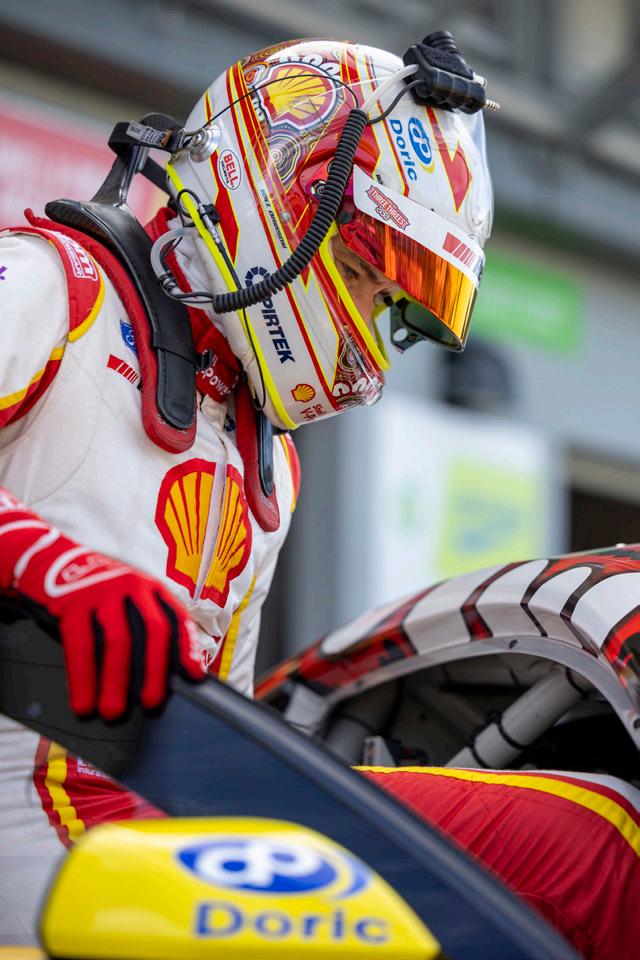

Rheem 12
It’s been an eventful start to the year for the Shell V-Power Racing Team. The 2023 season saw the introduction of a new generation of supercars, and Shell V-Power Racing Team’s Gen3 Ford Mustang GT Supercar hasn’t disappointed. Sporting a refreshed look on its iconic livery, the new supercar has broken new ground, while still paying homage to the Shell V-Power cars that fans have come to know and love. It should come as no surprise then that Rheem were happy to continue their partnership with the team for the seventh consecutive year.
“Shell V-Power Racing, Dick Johnson and Rheem are all industry leaders who apply industry best practice, innovation and excellence

in the areas that we operate in,” Chris Taylor, Rheem Australia Managing Director, confirmed. “That’s why Rheem is very excited to be once again partnering with the Shell V-Power Racing Team on and off the track.”
After a slow start to the year, the team recently took out a hard-fought win in Townsville. Racing in the new Gen3 Ford Mustang GT, Shell V-Power Racing Team driver Anton DePasquale claimed first place in Race 17 of the Repco Supercars Championship, which was the team’s first win for the season.

“It’s awesome to be sitting up here again and to get a trophy for the whole team,” De Pasquale said after the win. “Everyone at Shell V-Power Racing Team has been working hard. We haven’t had a great start to the season but we’ve slowly been turning that around and today everything worked out for us.”
Fresh off their first win for the year, the Shell V-Power Racing Team announced some more exciting news: their first ever wildcard entry into the Repco Bathurst 1000. The third Shell V-Power Ford Mustang GT will be driven by experienced Supercars and 5-time Bathurst driver Simona De Silvestro and rising star Kai Allen. De Silvestro was the first full-time female
driver in the Supercars Championship (2017), is a former IndyCar driver and current Porsche Factory driver – and she can’t wait to take on the famous Mount Panorama race track.
“I am thrilled to race back at the iconic track in Bathurst and want to thank DJR and Shell V-Power for this amazing opportunity,” she says. “Four years has been too long but who would have thought in 2019 that I would not be able to travel to Australia for such a long time. I am looking forward to teaming up with young talent Kai and I am sure we will make a great team.”
David Noble, Chief Executive Officer of Dick Johnson Racing, is equally excited about the news.
“This wildcard entry has been a long time coming for Dick Johnson Racing and we are extremely excited about it. To have the enthusiasm and talent of Kai mixed with the experience of Simona is the perfect combination. Of course, this wildcard entry wouldn’t be possible without the support of our wonderful long-standing partners Viva Energy Australia (Shell Licensee), WM Waste, Rheem and Pivotel, thank you.”
Rheem couldn’t be prouder of the team, and we can’t wait to see them in action at Mount Panorama!
Rheem proudly supports Save the Kiwi to achieve their goal and take kiwi from endangered to everywhere. If you’d like to take part and help save New Zealand’s national icon, go to www.savethekiwi.nz/donate – Your donation will help hatch and raise kiwi chicks in safety, increase kiwi populations, and protect wild kiwi habitat.
offsite 13
THE COLORCOTE TRADIE PROFILE

Rheem 14
WWW.COLORCOTE.CO.NZ
By Nick Jones
I’ve known Auckland plumber Jesse James Cassrels for some time. Apart from occasional bouts of seasickness, it’s hard to fault the guy. He’s outgoing, enthusiastic, and down to earth. He also does some pretty cool shit. A brief squiz of his Instagram page will reveal exotic locations, extreme sports, fast vehicles, and, of course, beautiful women!
So, how does Jesse manage to fit all this action into his tradie schedule? Quite easily, by the sounds. In fact, Jesse views his plumbing trade as the enabler, rather than the handbrake, for his adventures.
“Growing up on Auckland’s North Shore, I always had a passion for extreme sports and adventure. That’s probably why school wasn’t really for me. When I left school at 16, I wanted to become a pro-wakeboarder and travel the world. Luckily, my old man, who
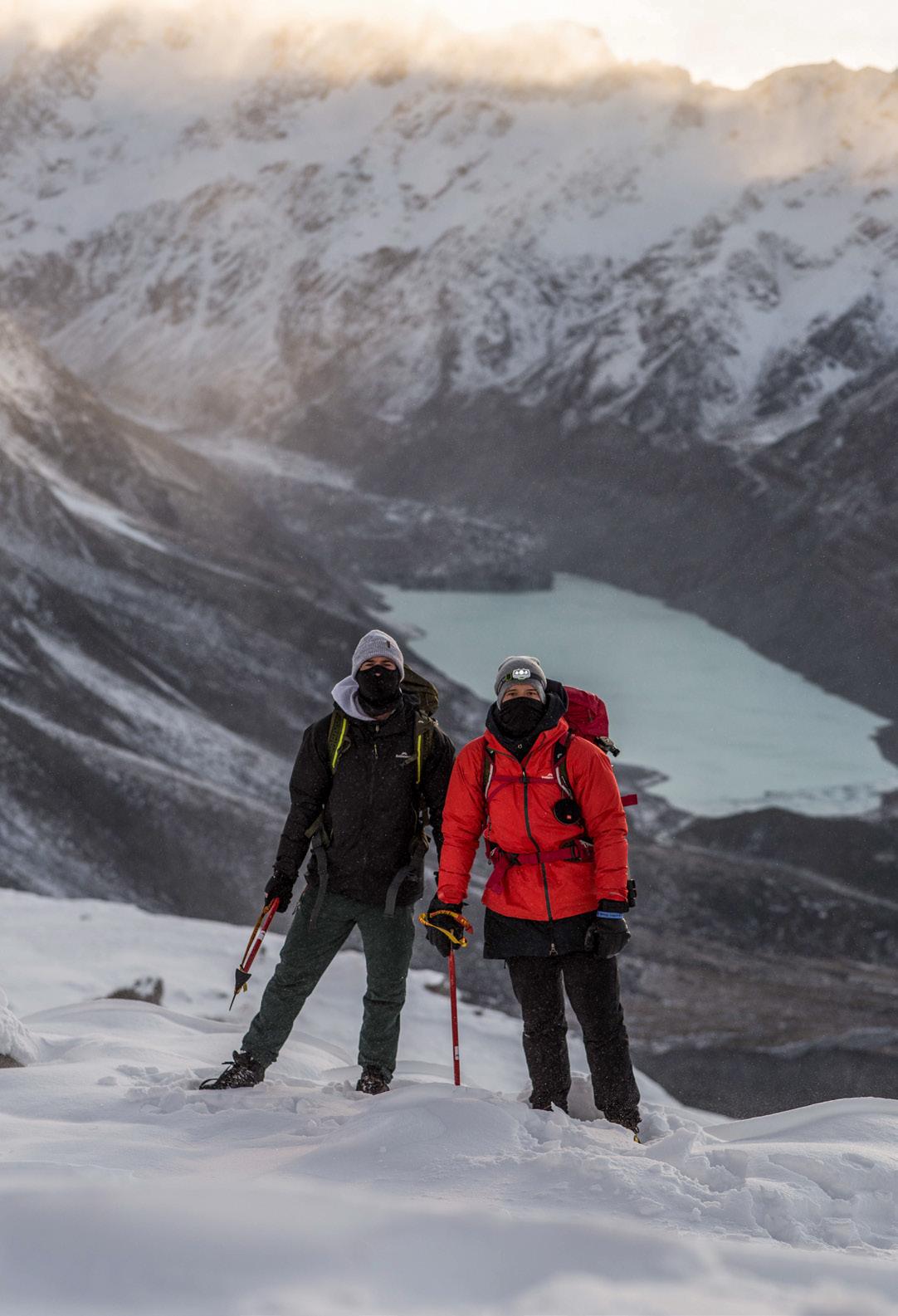
was an electrician, encouraged me to get into a trade apprenticeship.
“He probably knew I wasn’t a wordclass boarder, too,” laughs Jesse.
I asked Jesse why he chose plumbing.
“I kind of stumbled into it, to be honest. I always wanted to be a sparkie like my dad, but at that age, I think we might have butted heads a bit too much if he took me on! One of Dad’s friends was a plumber and lived nearby, so I started out with him. After only a week, I knew I loved it.”
JESSE JAMES CASSRELS
His romance with the tradie life continued to blossom. It was a good move for Jesse – by the time he’d finished his apprenticeship, he had a trade behind him and had saved enough cash to catch up with his penniless wakeboarding mates in America.
“I had a really cool boss, Eddie
offsite 15
Intrepid Plumber
from Eagle Plumbing. He didn’t mind me shooting off for three months of the year. After a few years, he said, ‘Why don’t you contract for me? That’ll give you more freedom and exibility.’
“So, I went out on my own and started Water Active Ltd. I love the residential stuff. You’re on a nice building site and can have a good relationship with the clients. It’s more personal, which suits my personality.
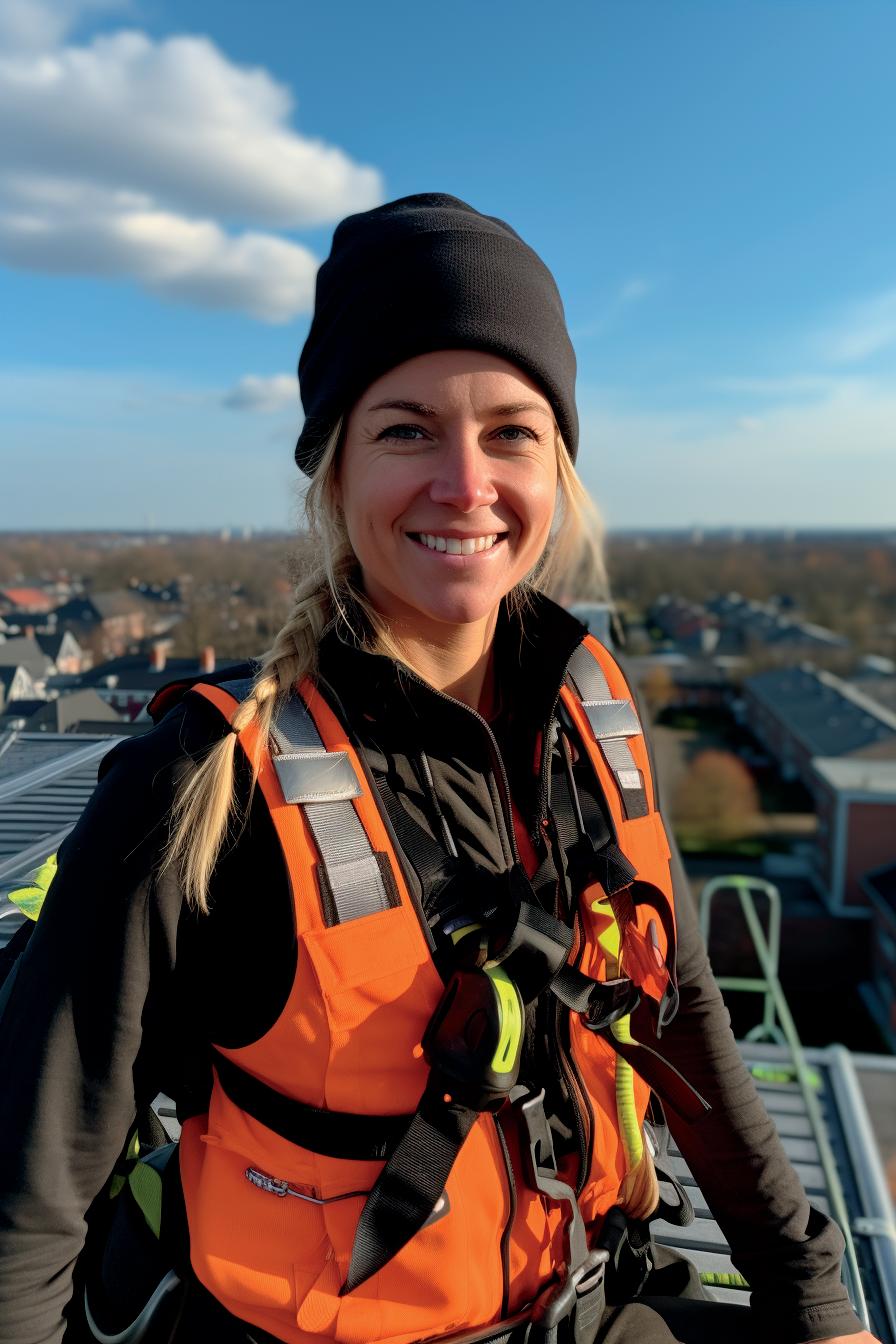





“I’m sure I’d enjoy commercial work, too. Residential is just what I’ve always done and what I know.”

A self-confessed adrenaline junkie, when Jesse isn’t on-site, he’s skydiving, sur ng, motorbiking, riding his
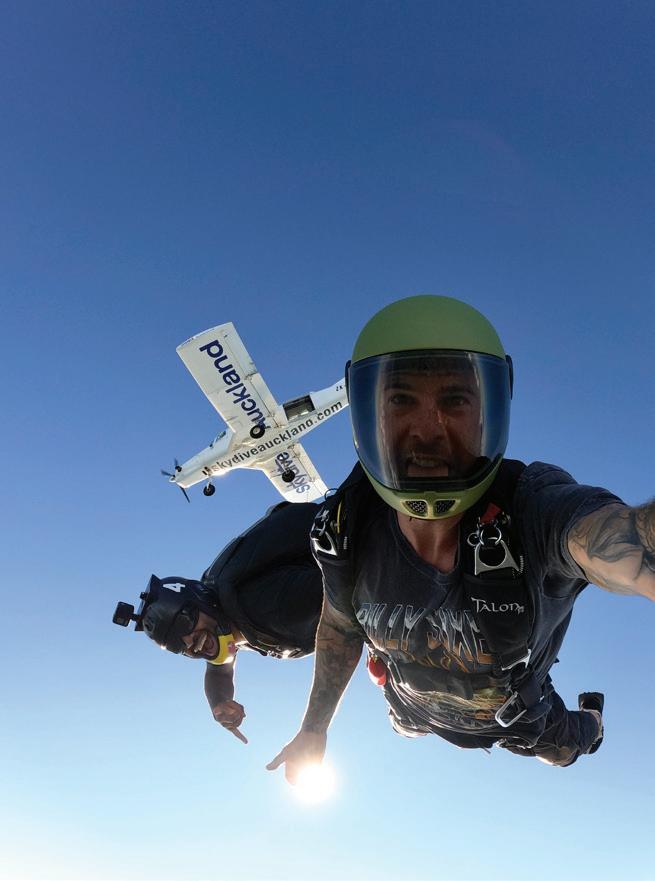
Yamaha WaveRunner, snowboarding, shing, or spear shing. If it’s exciting, you can bet he’ll give it a nudge.
“Plumbing has funded my travel and adventures. Should I have bought a house? Probably. Have I had a f**king good time? Absolutely!”
When I caught up with Jesse for a burger and a beer, he brought me some spoils from his latest adventure – a loin of gleaming southern blue n tuna. He’d been out with a mate the day before (on a weekday) and had an epic result, nailing not only two 40kg tuna but also a healthy bag of cray sh off the Coromandel.
“It was the dream day. Those are the ones you’ll always remember… that’s why I try to put my hand up for any mission on offer.”
I don’t know how he nds the time, but Jesse also gives back to the trade industry and community as a Trade Collective Ambassador.
“The Trade Collective is all about
educating and inspiring school leavers to think about taking up a trade. We want youth in NZ to reconsider some of their awed perceptions around trades.”
The concept is simple: they travel around Kiwi high schools with a genuine and relatable approach, sharing what a trade apprenticeship and career look like, and shedding light on the earning potential and lifestyle opportunities that the industry can offer.

“We just have a chat and try to make the presentations as interactive as possible. Some of the key messages are that tradies are in high demand, they can earn while they learn, and many will be set up to start their own business in their twenties.”
“We want to show these kids that with a good attitude and a trade under your belt, the world truly is your oyster.”
am
Rheem 16
Tradie-Profile.indd 1 18/05/2021 10:26:15
This tradie profile is brought to you by ColorCote

offsite 17
FRAMES
Frames is where we highlight Aotearoa’s most inspiring outdoor imagery. It’s the place in the magazine where you can slow down, take a deep breath, and truly appreciate the beauty of our backyard. Feast your eyes!
 Thomas Greenaway @thomosmoto.co
Thomas Greenaway @thomosmoto.co

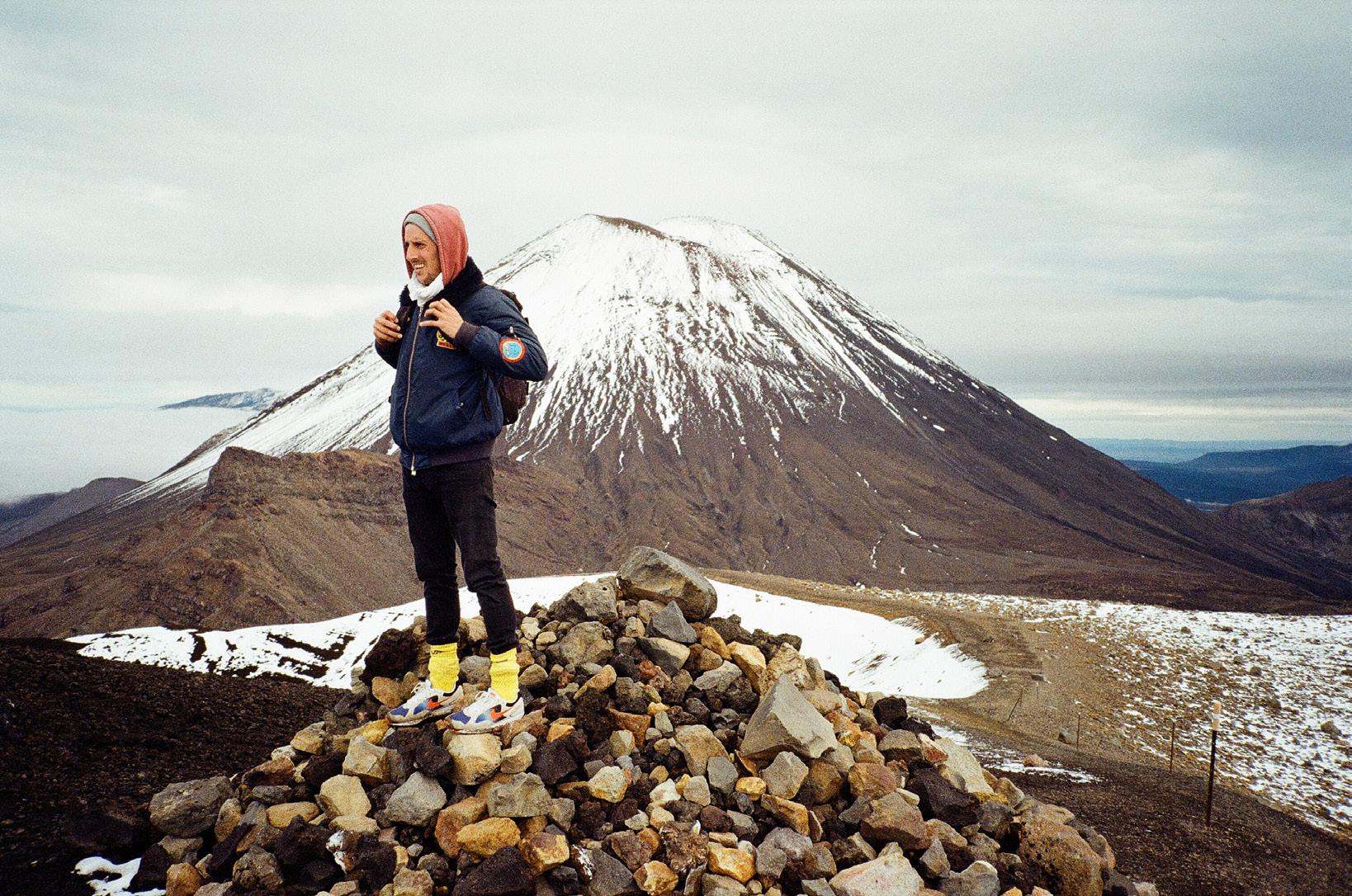
offsite 19
Thomas Greenaway @greenaway_72
Artje Schrijvers @artjeartje
Jason Harman @jason_harman
METHOD
Preheat the BBQ to medium-high heat using a flat plate or cast-iron pan.

GRILLEDJALAPENOBURGER
Divide the meat into 8 x 70g portions, then roll into balls and set aside. Slice the buns in half and add to the flat plate or skillet, toasting until golden.
Add the sliced jalapeños and grill until soft, don’t overcook the suckers. Remove and set aside. Add the meatballs, then using the smasher, push down hard with a twist motion
Your Shopping List:
• 4 brioche burger buns
• Jalapeño Ranch (I used Wiseboys)
• 2 Jalapeños, sliced
• 560g 80/20 beef
• 8 Slices gouda
• Crispy shallots
• Salt & pepper
Special Equipment:
• Burger Smasher
• Burger Flipper


making pencil-thin patties. If you’re using a skillet, you may need to do this one at a time. Season the patties with salt and pepper and cook for 1-2 minutes.
After a couple of minutes, flip the patties and top each one with a slice of cheese, cooking for a further minute.
To Build: Add a good dollop of the jalapeño ranch to the toasted bottom bun. Follow


this up with two patties, the grilled jalapeños, and crispy shallots. Crown with the top bun and dive in. Don’t sleep on these – they’re delicious!




Top Tip: Only smash a patty once! Once flipped, if you push down a second time, you run the risk of pushing all the juice out of the patty. No one likes a dry burger.
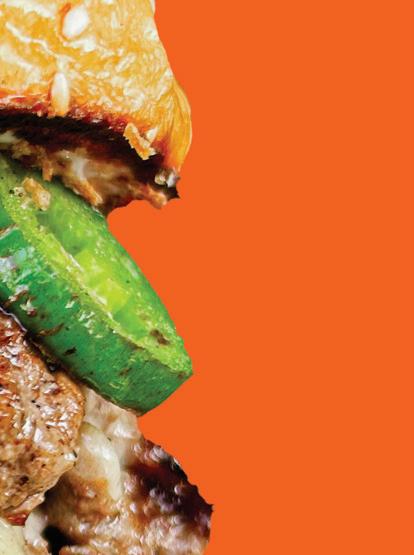


20
Recipe by Simon Walden @thetradiebbq
Mental Health Chat

Part 2: Mental Health First Aid
“I’m so over it!”
“I don’t think I can go another day.”
“Life is just too hard.”
Theoretically speaking, If I was to say this to you, would you know what to do? Or, more commonly, if I didn’t say it out loud but was thinking it, would you know the signs to look for?

In the construction industry, on average we are losing one person per week to suicide. Mental illness is killing six times more people than workplace accidents, and yet we are still so far behind in our mental health education and training. It’s time that we all stepped up and started to prioritise mental health in our health and safety plans – including education, training, and inductions.
We all have a ‘Workplace First Aid’ certificate. Why? So that if someone hurts themselves at work, we will have sufficient knowledge to deliver first aid
and look after them until professionals arrive. It’s just what you do; it’s part of our responsibility to our fellow human beings.
Well, mental health is the same.
I don’t believe anyone has the right to complain about suicide statistics, or what the government “should” or “shouldn’t” be doing if they are not doing anything to educate themselves first. It would be like complaining about the road toll but still driving intoxicated every time you got in your car. A little hypocritical, don’t you think? Each and every one of us has a role to play. Be the change you wish to see.
At present, there are loads of free training seminars throughout the country that will teach you how to support someone going through a mental health crisis. You are not expected to ‘fix’ people in mental distress or have all the answers for
them – just being able to notice the signs, ask questions, listen to them, and help get them the professional support they need is often enough.
We are very lucky in our industry to have Mates in Construction educating tradies throughout Aotearoa, but that is only as good as the few who get trained. If every single person on-site had some form of mental health training (just like first aid) I am convinced we would be able to reduce the suicide rate – not only in our industry but across the country.
The low death rate from workplace accidents on construction sites is no coincidence. It is low because of the huge amount of training, education, and investment around Health and Safety.
It’s time to do the same for mental health and normalise it as a workplace conversation in New Zealand.


offsite 21
In Part Two of our Mental Health Chat series, we have an insight from mental health leader and advocate, Glen Thurston. Earlier this year, Glen completed 53 summits of Corner Peak (1683m above sea level) in 53 days to highlight and protest the average yearly number of suicides in the New Zealand construction Industry.
COAST TO COAST:

RUTTING
Words and Images by Struan Purdie @earlybirdmedia
The chamois rut comes around once a year – a time when the bucks only have one thing on their mind. It makes it a great time to hunt them as invariably you’ll find them parked up by female groups with very little inhibitions.
This year, we had two awesome trips chasing these spectacular alpine critters. The first saw us make the fivehour drive over to South Westland for a two-day fly-in trip. Along for the ride was a good friend Christian who got the last-minute call up after our other mate got COVID. The fizz factor at the helicopter pad was at an all-time high.
Christian had never been in a chopper before and this was also his first time chamois hunting. The flight in was stunning as always – massive peaks punctuated by deep glacial guts. It all looked deceivingly achievable from high above.

The plan was to set up a plush base camp and then hunt a different corner of the block each day. We climbed high the first afternoon to get the lay of the land, spotting a bunch of tahr with at
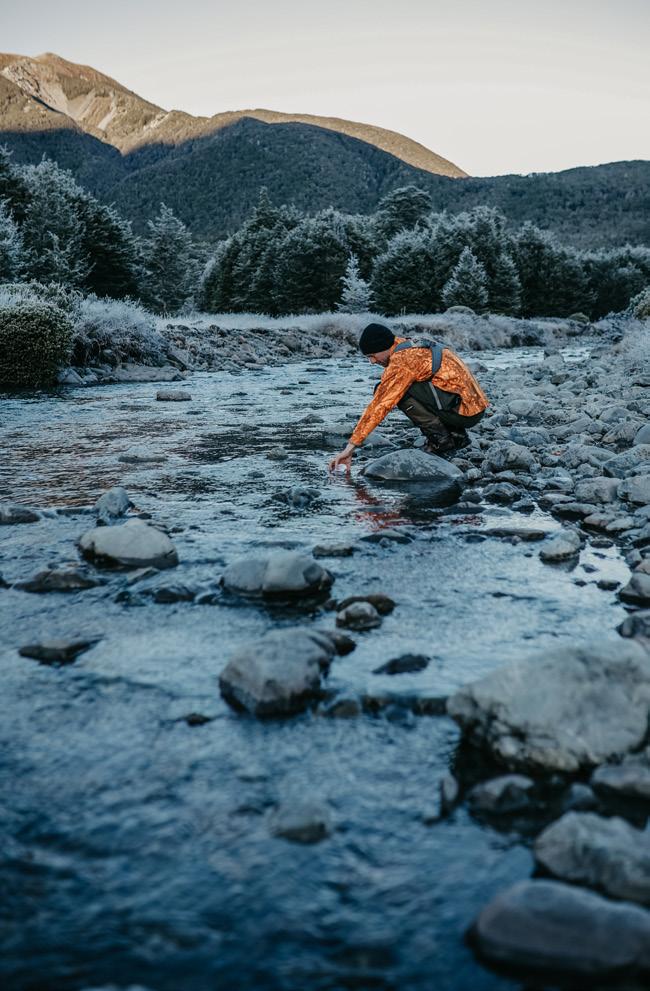
least two respectable bulls. However, they were over a kilometre away high on the opposite bluffs. As we kept climbing, we came across a memorial to a young Danish hunter who had fallen to his death on the same ridge in 2016. A good friend of mine had been flatting with him at the time so it certainly hit close to home how careful you had to be in these mountains. As we snapped a couple of pictures of the memorial, we suddenly spotted some tahr a few hundred metres away.
Although tahr wasn’t the first on the hit list for the trip, Christian had yet to shoot one so he got the call-up. Settling in behind the rifle, we lined up and waited for the perfect shot. Boom! Nothing. A clean miss. He tried a couple more times as the startled bull made his escape but no luck. For anyone who has hunted before, you’ll know the perplexing frustration of missing a shot for no apparent reason. It sticks with you as you replay it over and over. Lucky for Christian he had two good friends to keep reminding him of his misfortune well into that evening over multiple crafty beverages.
The next morning dawned fine and clear, but the forecast wasn’t looking good – cloud and rain from lunchtime so time was tight. We dropped down below camp to the scrub line to search for a chamois for Kyle to poke an arrow into. No bucks were spotted but we did come across a promising-looking nanny that Kyle managed to stalk to within 30 yards. However, the curse of the night before persisted with a second miss for the trip. With the cloud building, we decided to bail out and called for a
offsite


pickup before it clagged in completely. Despite our disappointment everyone was still stoked on an awesome trip into the hills, catching up and enjoying some downtime. I did, however, have some unfinished business securing a chamois buck.
Fast forward a month or so and we were on the road again. This time heading for some promising-looking country on the East Coast. The plan was to head up the main river valley on a couple of e-bikes with a mate Jon (whom some readers will recognise as the quintessential Kiwi from the Tradie
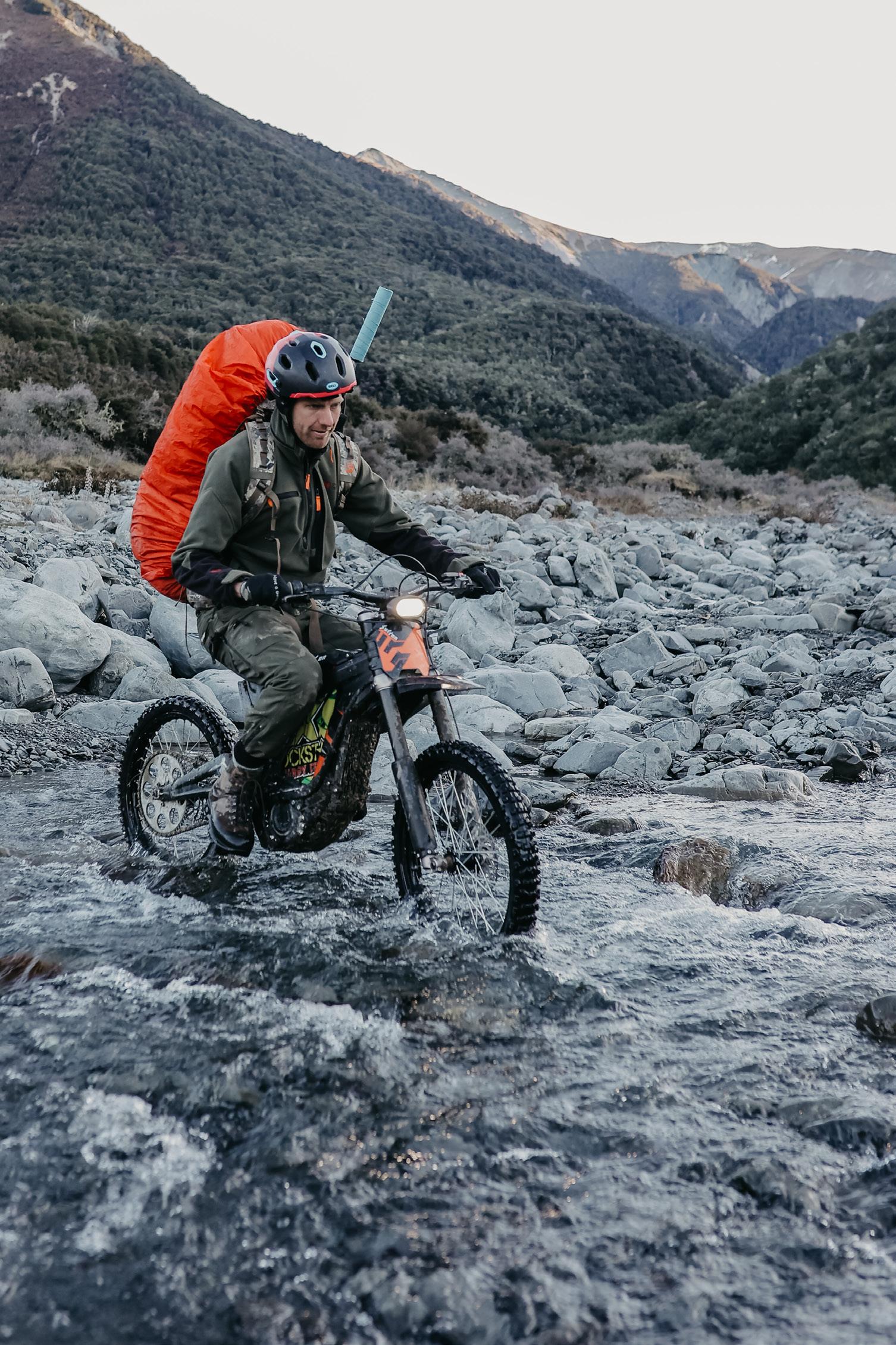
Profile in Issue 27 of Offsite). Once we’d depleted our batteries as much as we dared, we stashed the bikes and started to climb. It was a relief to get away from the valley floor which was frozen solid with no fresh animal sign. At this time of the year, most animals spend most of their time in the bush or up high where the sun reaches.
It took us the best part of three hours to smash out the 1,000m climb. Once we reached the top, our phones started dinging with some unexpected coverage. We mucked around half an hour video calling the whanau back
home before setting off again for the summit. We’d been walking all of 30 seconds when Jon looked back to spot seven chamois feeding a mere 200m from where we had just been noisily yarning. Through the binos, none of them were anything worthy of a bullet but I decided to drop down and see how close I could get for some photos. As I crept closer, I noticed a couple of the chamois kept peering downhill intently.
I scanned the hillside and eventually found what they were looking at. A lone buck was trotting intently up towards us, and he was completely unaware of my presence. A quick glass confirmed he was clearly a shooter with thick bases and solid tips. He was also clearly in full rut mode with his dorsal stripe along his spine puffed up to the max in the hope of getting some highcountry action. I waited until he was a mere 80m away then quickly drilled him just behind the shoulder. I heard Jon holler from a couple of hundred metres above. He’d watched the whole thing through his binoculars. The enormity of it all sunk in as we got down to the buck. He was a ripper – just over 9.5 inches with an awesome winter cape.
During my time photographing and guiding hunts I’ve seen some solid bucks shot, however, this was by far the biggest that I’d pulled the trigger on personally. We snapped a couple of pictures and spent the rest of the evening exploring the catchment before dropping back down to the valley floor in the dark. It had been an awesome adventure into some new country – made all the sweeter with an epic trophy for the wall. At the end of the day though, most hunters will tell you the real trophies are the memories of beautiful landscapes and great friendships that you come away with. These are what keep us coming back time and time again.
Rheem 26



YAMAHA YDX-MORO 07
THE BACKSTORY
With the YDX-Moro 07, Yamaha has brought an electric mountain bike (e-MTB) to NZ for the very first time. Despite its novelty on our shores, the Japanese manufacturer has some serious pedigree in the power-assisted bicycle arena, this year celebrating the 30th anniversary of its e-Bike and its systems. To give you some idea of scale, Yamaha rolled its five millionth e-Bike drive unit off the production line in 2019!
The Yamaha YDX-Moro 07 is advertised as a competitively priced, mid-level, all-mountain product with an electric motor and quality componentry. To the unschooled, the YDX Moro 07’s retail price of $9,099.99 NZD may sound like a fair bit of wedge for a mountain bike, but consider that entrylevel full suspension, non-electrified mountain bikes start at around a few grand, and many trail warriors fork out more than $10,000 for a new pushbike – electrified or not. It’s also significantly cheaper than any new, smalldisplacement 2-stroke motorbike. There’s no doubt that e-bikes are growing in popularity in our country,
particularly when you consider tightening controls on fossil-fuelled modes of transport. And it’s not hard to imagine the keen outdoor adventurer salivating at the breadth of possibilities that open up with an e-MTB – fun Sunday jaunts, trail riding, exploring off-the-beaten path, and enabling backcountry hunting and fishing adventures where motorbikes are not allowed or would be too heavy to manage.

CONSTRUCTION AND FEATURES
The YDX-Moro 07’s chassis and drive unit are integrated to create a machine where every component has been developed to work in harmony. The unique Dual Twin frame features twin top and down tubes that give a balance of flex and rigidity for confident handling.
Yamaha has not been afraid to partner with other class-reading componentry brands, either. Take the full RockShox suspension, 12-speed Shimano Drivetrain, Magura brakes and Maxxis tyres, as examples of Yamaha leveraging others unrivalled experience in the mountain biking world.
offsite 29
Words and Images by Nick Jones
MOUNTAIN E-BIKE
Producing 85Nm of torque, Yamaha’s latest PW-X3 is the company’s lightest, smallest and most powerful drive unit. Its compact dimensions offer balanced weight and excellent ground clearance for off-road conditions. Zero cadence technology provides instant assistance, and the Automatic Support Mode provides extra power on hills and into headwinds.
The 3kg, 500Wh battery is compact and fully integrated into the chassis to centralise weight. Depending on the environment and usage, Yamaha says the YDX-Moro 07 can provide a range of up to 136km, with an 80% charge taking one hour and a full charge taking four hours from a standard power point.
The chassis and motor are backed by a three-year warranty, while the battery and other componentry have two-year and one-year provisions respectively. There are dealers in both North and South Islands and technicians at those dealers have been thoroughly trained in assembling and servicing the YDX-Moro 07. There are Small, Medium and Large size options, and the overall weight is 23.2kg.
PERFORMANCE
The e-Bike concept is straightforward. When you start to pedal the Yamaha YDX-Moro 07, the electric motor helps out with its own oomph, with no separate throttle (or equivalent) for the electric thrust. It’s all very simple and it doesn’t take long to get a good feel for its operation.
Upon mounting the YDX-Moro 07, it feels nicely balanced, and the controls are simple and intuitive. A push lever control allows you to adjust your saddle height from your handlebar, and the Interface X – Yamaha’s minimalist
display unit mounted centrally on the handlebars – features clearly marked battery and assist indicators along with Bluetooth connectivity.
On our test day, we shot out to Woodhill Forest west of the Auckland metropolis. While I must admit I haven’t done much mountain biking, I took along fellow Offsite crew member Josh Williams who is better versed in the game.

We started off on the beginner trails, but the stability, smooth suspension (160mm fork and 150mm rear shock travel) and responsive brakes meant it didn’t take long before we’d built the confidence to move up the trail gradings. In addition, the YDX-Moro 07 utilises a gyroscopic system that limits power assistance while the bike is banked over during corners, to promote stability and confidence on corner exits. With the electric power and engineering, it didn’t feel like a 23kg unit. For example, lifting the front wheel to clear obstacles is a breeze.
The power assist can be set to
Rheem 30
five different intensity levels and also includes an auto setting. This is useful for newbies and experts alike – the electric motor is capable of providing plenty of power if you wish and it is a strange feeling braking before uphill corners! Speaking of going uphill, it was awesome to enjoy the experience without huffing and puffing – it certainly makes going back for a second crack on a fun downhill section much more palatable! Better yet, after a couple of hours on the hills the batteries were still showing as full on both of our test bikes.
The final verdict? Incredibly fun, simple to use, and easy on the lungs!


You can find out more about Yamaha’s YDX-Moro 07, dealers, and finance and insurance options online by scanning the QR code below.

offsite 31

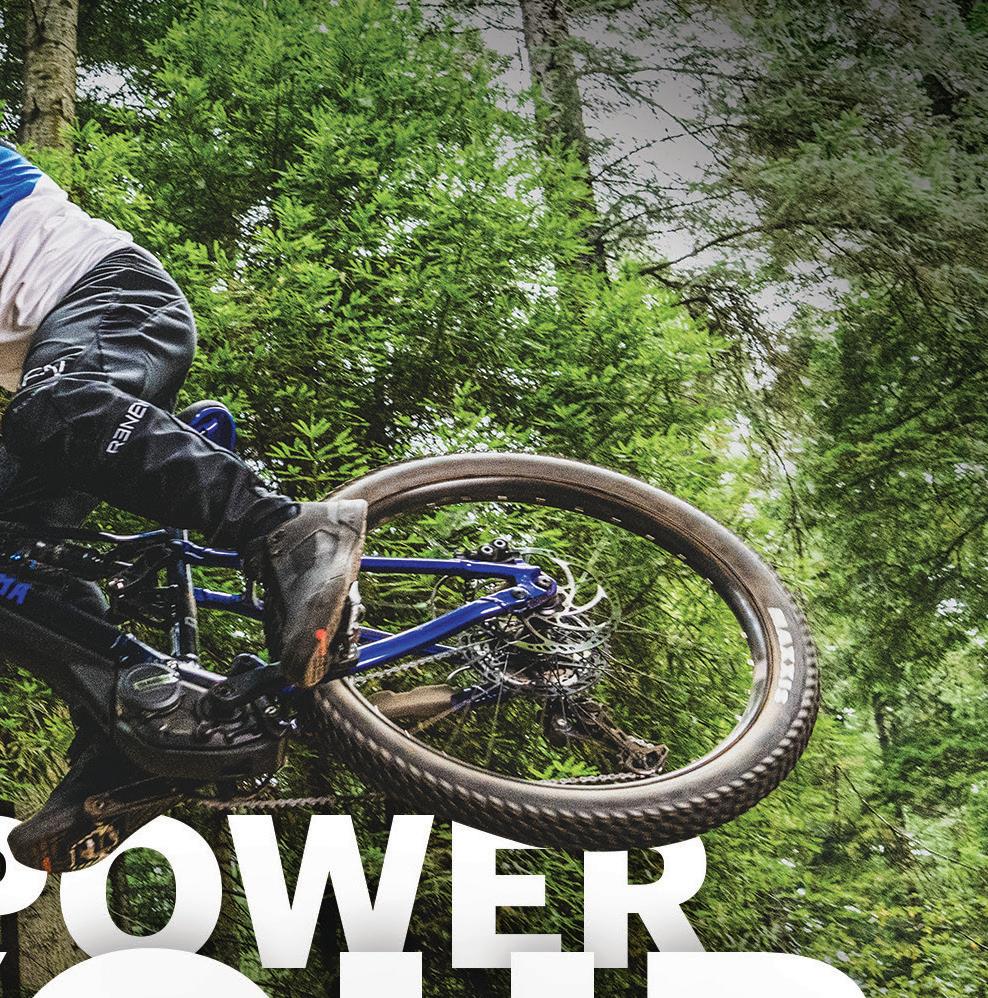
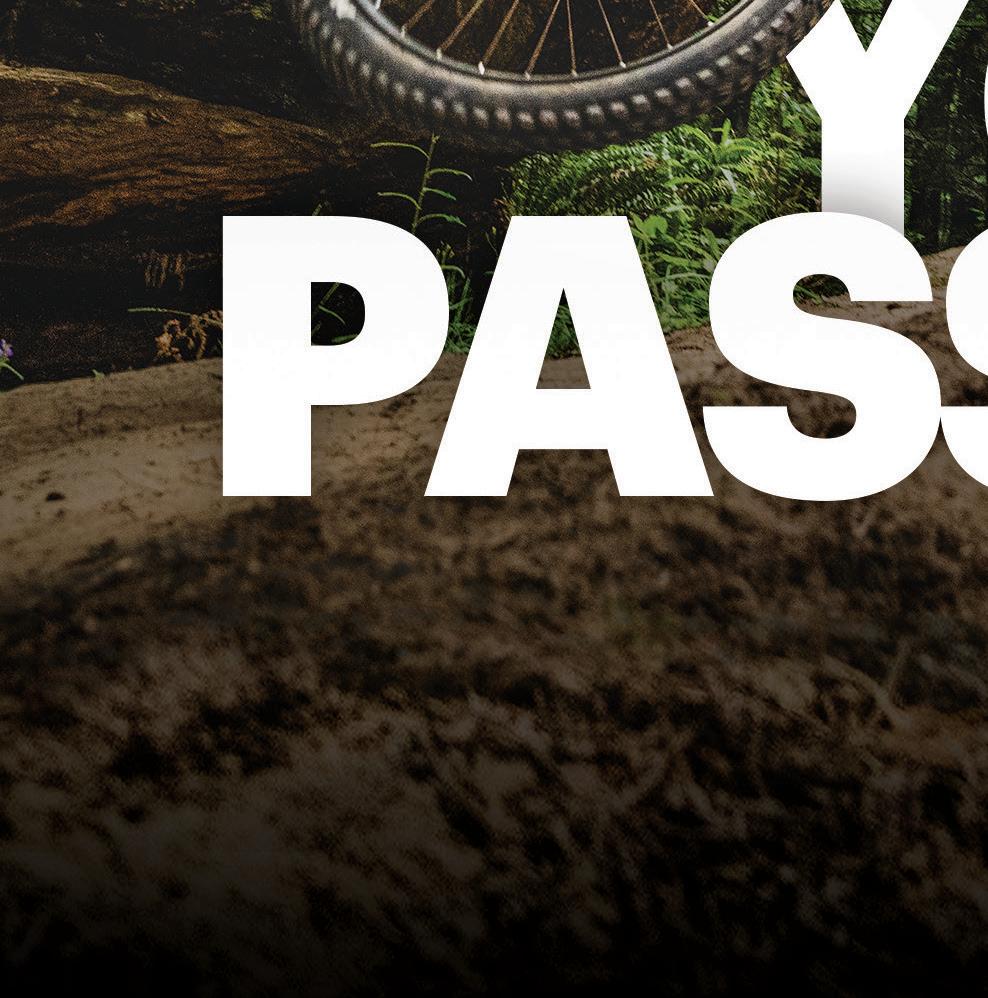







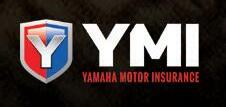
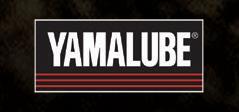

www.yamaha-motor.co.nz FIND YOUR LOCAL DEALER AT: NOW AVAILABLE IN NZ




























 Thomas Greenaway @thomosmoto.co
Thomas Greenaway @thomosmoto.co












































